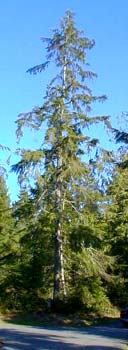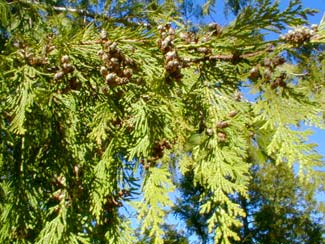
Western Red Cedar
"A hut, & a tree,
And a hill for me,
And a piece of weedy meadow.
I'll ask no thing,
Of God or king,
But to clear away his shadow."
-Max Eastman
(1883-1969)
(1883-1969)
Western Red Cedar or Pacific Redcedar (Thuja plicata) has gone by a variety of common names over time, including canoe-cedar because Salish peoples made enormous whaling canoes from it; Shinglewood because Northwest houses were traditionally shingled with cedar; & Giant Red Cedar or Great Western Arbor-vitae because of its majestic size & width.
It is not a true cedar but is one of the world's three arborvitaes, the other two being the Eastern White Cedar, & the Chinese Arborvitae. The tree known as Eastern Red Cedar is actually a juniper. Arborvitae means "tree of life" & coincidentally the Kakawaka'wakw tribe also called red cedar the Tree of Life.
Its oily wood makes it naturally waterproof & resistant to insects, so that it can remain intact for a century exposed to the elements. It also splits easily into rough straight boards & does not warp or twist. It was the wood of choice for native longhouses, dugout canoes, paddles, storage boxes, spoons, & other objects. The stringy bark was used for basket-weaving, mats, even for clothing, & root fibres made the best baskets. Bark tannins were useful for dying baskets & mountain goat wool.
 Typically the tribes of the Olympic Peninsula would use old growth trees only when they had fallen in storms, but would not kill a living cedar. The tree was venerated, & religious objects including festival & ritual masks were preferably made of the sacred wood.
Typically the tribes of the Olympic Peninsula would use old growth trees only when they had fallen in storms, but would not kill a living cedar. The tree was venerated, & religious objects including festival & ritual masks were preferably made of the sacred wood.A native folk tale held that the Great Spirit brought the first red cedar forth from the grave of a man who had spent his life doing only good for the people. It was thought that by leaning against the tree, the spiritual strength of the red cedar could be transferred to whoever venerated the tree.
Among whites it became similarly popular for shakes, posts, split rail fences, indoor & outdoor furniture, decks, window frames, & indoor paneling. Without the respect afforded it by earlier tradition, not only do whites delight in cutting them down, but even in places where they are protected, they're among the first trees taken out by poachers due to their high value.
They can live for 800 or a thousand years, & 3,000 year old trees have been documented, although alas the evidence of their age is generally noted after they are cut down, & the groves of truly ancient cedars encountered by early explorers are today to be experienced only in the most out-of-the-way places, & rather few of those. A famous stand is preserved & can be experienced on Long Island in Wallapa Bay, Washington, the last such stand in the state, so that to see so many of these giants in one place is profoundly bittersweet. Similar stands in British Columbia are by & large inaccessible.
Only rarely encountered in pure stands, the western red cedar is commonly seen in mixed forests with Douglas-fir, western hemlock, or Sitka spruce. It grows throughout the coastal Northwest & throughout an inland rain belt of the Rockies, from sea level to the midzone of mountains. It does not like dry regions & when encountered outside of rainy regions, it is a smaller tree.
The female or seed cones are eggshaped. At half an inch or so, the female cones are larger than the reddish male or pollen cones. Its limbs begin to droop then turn outward. The overall shape of the tree tends toward pyramidal. The shiny green scale-like foliage forms flat fans, & have the wonderful cedar scent. The trunk becomes enormous at the base, & the tree can be as tall as 200 feet in old growth forests, though more often seen in the sixty-foot range.
As a garden tree, a sapling can put on three or more feet per year to quickly become an attractive specimen. Of our larger native trees, the red cedar is much better rooted than the Douglas-fir or Western hemlock, so that large trees are safer in a courtyard shading buildings. The swiftest growth is in full sun, but young cedars are somewhat shade tolerant too.
I photographed some natural wild cedars on a friend's property, but there do exist cultivars, including several that are compact, mid-sized, slow growing, or dwarf, hence suited for smaller gardens, including for examples 'Doone Valley,' 'Stoneham Gold,' 'Collyer's Gold,' 'Sunshine,' 'Filifera Nana,' 'Pygmaea,' 'Hogan,' 'Cuprea' (aka 'Spring Gold'), 'Grune Kugel,' & many others.